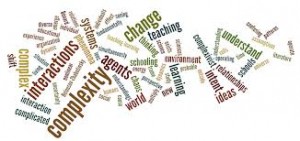Organizations are complex evolving systems. Just about all the things going on in organizations are complex interactions of people, changing technology and the changing environment. Change is happening all the time.
This idea is in sharp contrast to our more mechanistic thinking that is common in many organizations where change is seen as a nuisance and people just wish management would make it stop. When I was the Plant Manager people pushed me constantly to slow all the changes down and prioritize the things we needed to do. Yet changes were coming fast and furious. At one point I asked them how do I prioritize an avalanche? I could work on the stuff for today, but tomorrow brought a new set of changes and all the priorities would change.
 When I began to learn about chaos and complexity science, I saw that this was the way to handle the high level of change. As we shared more and more information, helped people to really understand the nature of the business and their important roles in its success, and as we built more trust and interdependence, people began to step forward to help us take on all the changes that poured into our organization. I did not have to do everything myself, which was a great relief.
When I began to learn about chaos and complexity science, I saw that this was the way to handle the high level of change. As we shared more and more information, helped people to really understand the nature of the business and their important roles in its success, and as we built more trust and interdependence, people began to step forward to help us take on all the changes that poured into our organization. I did not have to do everything myself, which was a great relief.
One of the key ideas was the creation of the BOWL. Control of the organization shifted from edicts and directions just coming from me to building the BOWL which was our co-created mission, vision, standards, principles, and expectations. When people had internalized these ideas, they could operate with a lot of freedom as long as they stayed within the BOWL which they always did. We talked a lot about this and just about everyone had a good understanding of it and their responsibility related to it. With the BOWL we could have order and freedom simultaneously without the organization falling apart.





